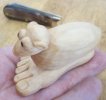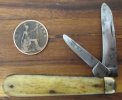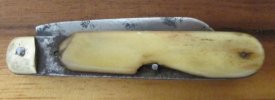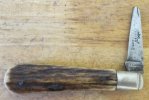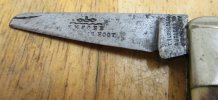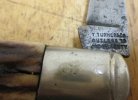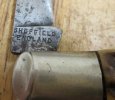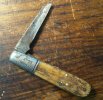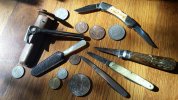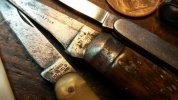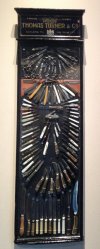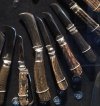My understanding of Odysseus greatly increased when I read his story as an older man.
Yeah, I'm another rusted on fan of
The Odyssey and Homer. One thing I've grown to appreciate more in recent rereadings is the excellence of the blind poet's technical descriptions. Check out the meticulously observed description of Odysseus felling timber, and hewing planks, to construct his vessel to escape Calypso's island. Or the comparison to an hot, forged axe, or adze being quenched, when Odysseus - or
No One - puts out Polyphemus' eye.
It's been my favourite book since I was a boy

I've read it many times (and studied it at school), and I think I enjoy it more every time

That row with the suitors is quite a tussle isn't it?!


LOL!

I can pinch open most of my Lambsfoot blades, but I doubt that'll go on forever

+1 on that, my friend, and let's not forget all the great English renditions of Homer and
The Odyssey through the past few centuries, as well as its 20th century offspring,
Ulysses...
Hmmm, anyway, back to all things Lambsfoot:
Pinchable blades are also useful, due to being ambidextrous, for us leftys.
Hey Jack, I was doing a little digging this weekend on a search for the earliest known Lambsfoot folder. There have been some good discussions and history on the Sheepfoot folders which go way back, but the Lambsfoot models seem to be more recent by comparison. While there are plenty of Sheepfoot models shown in late 19th century Joseph Rodgers and Wostenholm catalogs, those two companies don't show any Lambsfoot models until after the turn of the 20th century. From one of your previous posts, we do know that Taylor's Eye Witness had Lambsfoot models in their 1897 catalog but how much earlier can we date these? The oldest I can find so far is from Thos. Makin & Son circa 1890 (with picture enclosed). Have you had any luck in tracking down more history on the Lambsfoot models?

Excellent post, and detective work on that early Thos. Makin & Son, Herder my friend - we must be thinking along the same lines, as just this past weekend, I went looking back through this thread myself. (A good read too, for anyone who hasn't done so, and has a little time to while away.)
I was also thinking to establish a timeline of 'cardinal points' in our historical span; around the genesis, and subsequent uptake, and refining of the form to the classic swayback handle, tapered spine-to-edge blade profile of the quintessential 'Real Lambsfoot', today.
So if I can make a brief summary of our rough timeline so far -
The comprehensive-seeming nature of the tool patterns depicted in
Smith's Key of 1816, and the lack of recognisable Lambsfoot pocketknives in that work, would lead one to make an educated guess that the pattern most probably dates after 1816.
Then if we consider the English working cutlers who migrated to Connecticut and Massachusetts in the 1840s and 1850s and formed a large part of the workforce of the Waterville Cutlery Co. and later, Northfield Knife Company, and that they likely would have brought with them knowledge of all the popular patterns of the day - again, we seem to have no Lambsfoot patterned pocketknives here. (I referenced the 1869 Northfield catalogue here - if anyone has paperwork for Waterville Cutlery Co., that would be very interesting to check.)
I don't really recall seeing anything earlier than your example, Herder.
Jack, this Alfred Blackwell you posted
waayyy back at the start of this thread seems quite old, but I saw you did mention that it was quite beaten up when you got it. Are we just looking at a very worn example?
Here's an old Sheffield Lambsfoot by Alfred Blackwell. Alfred was the son of Joseph Blackwell, who was himself the son of a spring-knife cutler (also Joseph), and making knives in Radford Street, Sheffield from 1833. In 1861, Joseph Blackwell & Sons employed four men and three boys. The sons were Alfred (who was born in 1834) and Henry. By 1868, the firm was working from
Liberty Works on Edward Street. As Joseph grew older, the reigns of the firm were increasingly taken over by Alfred, and by 1881 Joseph had retired (dying at Stannington in 1884). Joseph continued to trade in Holly Street.


This old knife has clearly seen lots of use, and it looked like it had been run over when I found it in a local flea-market. It still takes a razor-edge though, and has great W & T, as well as great character I think

Any idea - or even an educated guess - on when that knife might date from, Jack? Which Lambsfoot knives in your collection seem like the earliest examples to you?
The latter half of the 19th century must have been a time of considerable innovation and a certain amount of fluidity, in what we would today regard as 'canonical' patterns.
Taking that Taylor's Eye Witness 1897 catalogue as an example, check out the wide variety of handle and blade shapes on just two pages:
The gold rush migrations to California and New South Wales, must have presented another 'river of gold' to Sheffield's toolmakers. And these burgeoning markets were in addition to the East Africa, India, Canada, New Zealand, Malayan and Caribbean export trades in edged tools.
With the 'McKinley' Tariff Act passed in the US in 1890, which (temporarily) saw the average duty on imports raised to 50%, Sheffield manufacturers realigned to focus on other large export markets than the US.
If the Lambsfoot pattern was part of the models which were developed (and in some cases, based on earlier, regional patterns), and were first popularised during the 1890s, then this window would partially explain why it does not appear in homegrown US examples, but was still evident in British colonies, at the time.
A realisation that they were now facing competition - and counterfeiting - from many quarters, meant that Sheffield factory owners also pursued many cases of trademark infringement, where they were able to. I wonder if the whole 'Real...' epithet that appears on quite a few patterns, was a response to general widespread misuse of Sheffield sounding company names, and counterfeiting at the time?
Certainly from the early 1900s to the 1930s, and on, there seems to have been quite a wave of popularity, both of the 'Real Lamb Foot' patterns:

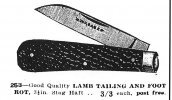
and the usage of the 'Lambsfoot-style' tapered blade in other patterns, like sporting knives:
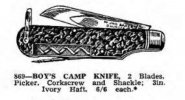
and some of the Australian agricultural and veterinary patterns:
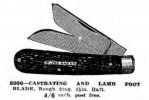

Greg, I love your piece - whittled with skill and humour, my friend!
(Now I'm guessing that wasn't done with either of your Lambsfoot pair?)



